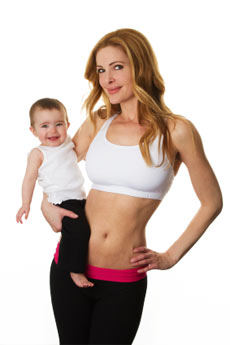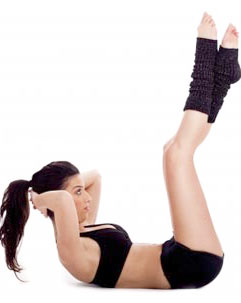|
|
Working the Transverse Abdominus After Childbirth
 During pregnancy,
the three different layers of abdominal muscles get stretched to
accommodate the growing baby. The belly stretches during pregnancy and so do the
muscles that cover it. These muscles are then held in a stretched position until
the baby is born, and because of this might lose some strength and elasticity.
For about one-third of all pregnant women, the ab muscles will actually split
down the middle at some point during pregnancy, labor, or delivery, and lead to
a condition called diastasis
recti. This
condition can lead to greater lower
back pain,
as the core muscles are not able to work as effectively. During pregnancy,
the three different layers of abdominal muscles get stretched to
accommodate the growing baby. The belly stretches during pregnancy and so do the
muscles that cover it. These muscles are then held in a stretched position until
the baby is born, and because of this might lose some strength and elasticity.
For about one-third of all pregnant women, the ab muscles will actually split
down the middle at some point during pregnancy, labor, or delivery, and lead to
a condition called diastasis
recti. This
condition can lead to greater lower
back pain,
as the core muscles are not able to work as effectively.
What is Transverse Abdominus?
Along with the obliques and
the transverse, there are two sets of opposing diagonal muscles that wrap around
the sides of the torso. There�s also a wide band of muscle that wraps
horizontally like a cummerbund and attaches onto the back of the body. All of
these muscles overlap each other to provide maximum coverage to the precious
organs (and precious baby in utero!) beneath. They need to be strengthened to
create a support system for the lower back.
Exercises to overcome Diastasis Recti
-
Reverse Breathing �
tones deep muscle layers of abdomen and spine. Post pregnancy, the aim of
this exercise is to assist closing of the lower part of the body, pull the
stretched muscles inwards and upwards, and strengthen them so they hold the
spine, pelvis and abdominal organs in the correct alignment.
Lie comfortably, spine supported. Place your hands on the lower abdomen.
Breathe in deeply, imagining the energy of the breath being drawn up through
the base of your body into the abdomen. As you breathe out, pull in your
waist, drawing your navel up and closer to your spine at the back. Feel this
out-breath continue to flow up into your chest, toning you powerfully from
inside. Release at the end of the exhalation. The out-breath is stronger
than the in-breath, but should never be forced. Either take a �resting
breath� in and out before inhaling and drawing up again, or repeat the
Reverse Breathing without a pause.
-
Towel Assisted crunches -
Take a long towel and wrap it around your torso with the ends in front and
as you perform a crunch� Pull the ends of the towel towards each other in
front of your belly button to help urge the muscle back together. Perform 2
sets of 10 reps (work up to 40 reps per day as you get stronger).
-
 Cross leg sit ups - Lie
on your back with knees bent and feet on the floor. Place your hands on your
pelvic belly, below the navel. Breathe for a few minutes, without effort,
feeling the belly rise and fall with each breath. Then cross the right thigh
tightly over the left. As you keep the hips on the ground, draw both legs
into your chest. Clasp your hands behind your head, exhale, and bring the
head up. Keep the head and knees curled in toward one another for an entire
set of eight abdominal
crunches. Exhale to bring the knees in toward your chest and slightly to
the left, while your head curls in and leans to the right. Inhale to release
the knees and head away from one another. After two sets, change legs. Cross leg sit ups - Lie
on your back with knees bent and feet on the floor. Place your hands on your
pelvic belly, below the navel. Breathe for a few minutes, without effort,
feeling the belly rise and fall with each breath. Then cross the right thigh
tightly over the left. As you keep the hips on the ground, draw both legs
into your chest. Clasp your hands behind your head, exhale, and bring the
head up. Keep the head and knees curled in toward one another for an entire
set of eight abdominal
crunches. Exhale to bring the knees in toward your chest and slightly to
the left, while your head curls in and leans to the right. Inhale to release
the knees and head away from one another. After two sets, change legs.
-
Wide-leg Circles - Lying
on the back, with one leg raised and reaching through ball of foot, draw big
circles with the leg while minimizing movement in the pelvis and back.
Points to Consider
-
Cut out processed foods, including sugar,
try cutting out wheat & dairy as well for a few weeks.
-
Drink plenty of water &
herbal teas to encourage digestion.
-
Eat plenty of fibre in
the form of whole fruits & vegetables & wholegrain carbs such as wholegrain
rice, quinoa, rye, oats & spelt.
-
Maintain proper posture, when you�re standing, your weight should be
through your heels, not the balls of your feet. You should be able to lift
your toes & your butt should curve out.
-
Avoid exercises where you�re lying on your back and lowering your legs
(such as straight leg raises, dipping the toes, single leg stretches, the
100s).
-
Do not do any heavy lifting or yoga
poses that stretch out your
abs so for example� Avoid yoga poses like the cow pose, up-dog, all
backbends�
Do not, do crunches or sit-ups post-baby, if you have abdominal separation.
Dated 06 September 2012
Related Links
|
|
|
|
|









